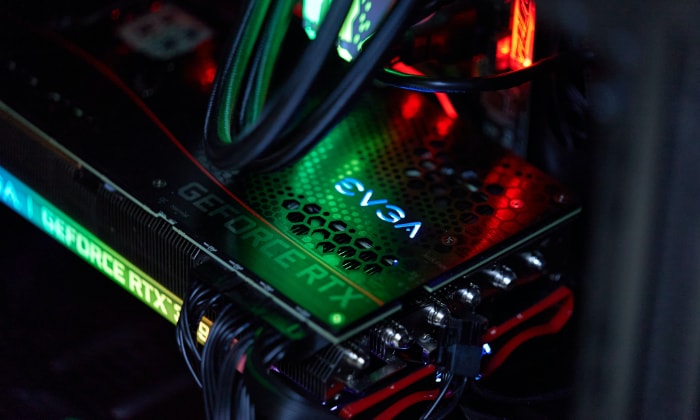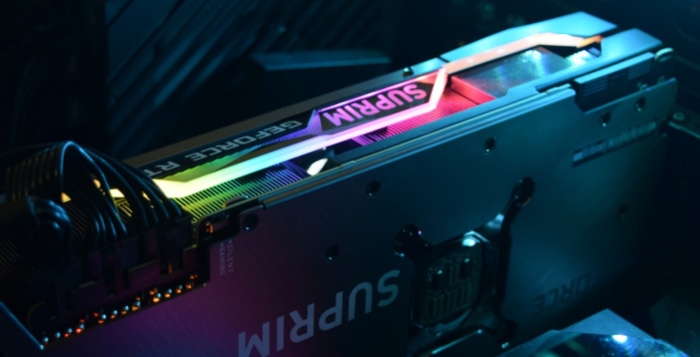What Is GDDR6X? Elevating Graphics to New Heights

Graphics memory technology continually evolves, shaping the way we experience computing and gaming. One of the latest advancements in this domain is GDDR6X, a high-speed memory interface that promises to revolutionize graphics performance.
As demands for more immersive gaming, realistic graphics rendering, and faster computing grow, understanding the role and capabilities of GDDR6X becomes crucial.
Background of Graphics Memory
Graphics memory has been a cornerstone in the evolution of computer technology, playing a vital role in defining the capabilities of graphics cards and systems. Its development over the years has seen significant leaps, each contributing to enhanced performance and better user experiences in computing and gaming.
Evolution from GDDR5 to GDDR6
The journey from GDDR5 to GDDR6 marks a significant leap in graphics memory technology. GDDR5, once the standard, offered substantial bandwidth improvements over its predecessors, enabling better gaming and high-resolution video playback.
However, as technology progressed, the need for even greater bandwidth and efficiency led to the development of GDDR6. GDDR6 brought about higher data rates, lower power consumption, and greater memory density, making it a substantial upgrade for graphics-intensive applications.
Overview of GDDR6 Features
GDDR6, the predecessor to GDDR6X, set new benchmarks in memory performance. It provided enhanced memory speeds and bandwidth, allowing for smoother graphics and more responsive gaming experiences.
The technology was not just about speed; it also focused on energy efficiency, which is crucial in modern, high-performance computing environments. GDDR6’s design improvements, including better signal integrity and error correction mechanisms, made it a robust and reliable choice for high-end graphics applications.
The Need for Faster Memory
As digital media and gaming industries grow, the demand for faster and more efficient memory also increases. High-definition gaming, 3D rendering, and complex computational tasks require memory solutions that can handle large amounts of data quickly and efficiently.
This need for speed and efficiency paved the way for the development of GDDR6X. It addresses the growing demands of modern applications, offering improved performance metrics that are essential in today’s fast-paced digital world.
The evolution of graphics memory, from GDDR5 to GDDR6, and now to GDDR6X, reflects the dynamic nature of technology. Each iteration brings with it new possibilities, enabling more complex and visually stunning graphical experiences.
As we move forward, the continuous improvement of graphics memory remains key to unlocking the full potential of both current and future computing technologies.
Introducing GDDR6X
The advent of GDDR6X marks a significant milestone in the realm of graphics memory technology. This advanced memory standard is designed to meet the ever-increasing demands of modern graphics processing, offering significant improvements over its predecessor, GDDR6.
GDDR6X stands out with its enhanced speed, efficiency, and performance capabilities, making it a key component in the latest high-end graphics cards and gaming systems.
Key Differences Between GDDR6 and GDDR6X
GDDR6X differentiates itself from GDDR6 through several critical advancements. The most notable is the increased bandwidth and data transfer rates.
While GDDR6 brought substantial improvements over GDDR5, GDDR6X takes this a step further, providing even higher speeds and more efficient data handling. This is crucial for applications that demand high-resolution graphics and rapid data processing, such as advanced gaming, virtual reality, and professional graphic design.
The Technology Behind GDDR6X: PAM4 Signaling
At the heart of GDDR6X’s enhanced capabilities is the implementation of PAM4 (Pulse Amplitude Modulation with 4 levels) signaling. This technology is a departure from the traditional NRZ (Non-Return to Zero) signaling used in earlier memory standards, including GDDR6. PAM4 allows for transmitting twice the amount of data per clock cycle compared to NRZ, effectively doubling the bandwidth.
This technical innovation is key to GDDR6X’s superior performance, enabling faster and more efficient data transmission.
Impact on Performance and Efficiency
The increased bandwidth and data rates of GDDR6X have a direct impact on overall performance and efficiency. Graphics cards equipped with GDDR6X memory can handle more data at faster speeds, translating to smoother and more detailed graphics in gaming and other graphics-intensive applications.
Moreover, despite its increased performance, GDDR6X maintains comparable power efficiency to GDDR6, ensuring that the enhanced capabilities do not come at the cost of significantly higher energy consumption.
GDDR6X represents a forward leap in graphics memory technology, setting new standards for speed and efficiency. Its introduction is timely, aligning with the growing needs of advanced computing and gaming industries.
As technology continues to advance, GDDR6X is poised to play a crucial role in shaping the future of graphics processing and the overall user experience in various digital domains.
Technical Specifications of GDDR6X

GDDR6X is characterized by its advanced technical specifications, which set it apart in the landscape of graphics memory. This section dives into the key aspects of GDDR6X, including its memory speeds, bandwidth, energy efficiency, and compatibility, providing a comprehensive understanding of what makes this technology stand out.
Memory Speeds and Bandwidth
One of the most significant features of GDDR6X is its impressive memory speed. GDDR6X modules are designed to operate at significantly higher speeds compared to GDDR6.
This translates to increased bandwidth, which is crucial for handling the large amounts of data required in high-resolution gaming and graphics processing. The enhanced speed and bandwidth of GDDR6X enable smoother rendering of complex graphics and more efficient processing of large data sets.
Energy Efficiency and Power Consumption
Despite its increased performance capabilities, GDDR6X maintains a focus on energy efficiency. The technology is designed to provide higher bandwidth while keeping power consumption in check.
This is achieved through various optimizations in the memory architecture, ensuring that GDDR6X can deliver top-tier performance without disproportionately increasing energy requirements. This aspect is particularly important in the context of environmentally conscious technology design and the need for energy-efficient high-performance computing solutions.
Compatibility and Implementation
GDDR6X’s compatibility with current technology is another critical aspect of its design. As a cutting-edge memory standard, GDDR6X is primarily implemented in high-end graphics cards and gaming systems.
It is essential for users to consider the compatibility of their existing hardware with GDDR6X to fully leverage its benefits. The adoption of GDDR6X in new graphics cards and systems signifies a move towards more advanced and capable computing hardware, poised to take advantage of the latest developments in graphics technology.
The technical specifications of GDDR6X paint a picture of a highly advanced memory technology, designed to meet the needs of the next generation of computing and gaming. With its exceptional speed, efficiency, and compatibility, GDDR6X is well-positioned to be a transformative force in the realm of graphics memory, offering substantial benefits for a wide range of applications.
Advantages of GDDR6X
GDDR6X stands at the forefront of graphics memory technology, offering a range of advantages that significantly enhance computing and gaming experiences. These benefits stem from its technical prowess, encompassing aspects like increased speed, bandwidth, and improved efficiency.
Here we explore how these advantages position GDDR6X as a superior choice for various high-performance applications.
Enhanced Gaming and Computing Performance
The most immediate advantage of GDDR6X is its impact on gaming and computing performance. The higher bandwidth and faster memory speeds greatly reduce bottlenecks in data processing, allowing for smoother and more detailed graphics.
This is especially beneficial in high-resolution gaming, where every frame counts. The faster memory also improves the overall responsiveness of applications, making GDDR6X-equipped systems ideal for both avid gamers and professional users in graphics-intensive fields.
Impact on Graphics Rendering and VR Applications
GDDR6X’s advanced capabilities significantly benefit graphics rendering and virtual reality (VR) applications. The enhanced memory speed and bandwidth allow for quicker loading and processing of high-resolution textures and complex 3D models.
This results in more realistic and immersive environments in VR, where rapid data processing is crucial for maintaining the illusion of reality and preventing motion sickness.
Benefits in Professional Graphics and Video Editing Tasks
Beyond gaming, GDDR6X also offers considerable advantages in professional graphics and video editing. These fields often require handling large files and performing complex rendering tasks.
The increased speed and efficiency of GDDR6X enable quicker rendering times, smoother playback, and more efficient handling of high-resolution video files. This makes GDDR6X an attractive option for professionals in these industries, where time and accuracy are paramount.
The array of benefits provided by GDDR6X underscores its importance in the current technological landscape. Its ability to handle demanding applications with increased efficiency and performance makes it a significant upgrade from previous memory standards.
As we continue to push the boundaries of graphics and computing, GDDR6X emerges as a crucial component in driving forward these advancements.
Challenges and Limitations
While GDDR6X offers substantial advancements in graphics memory technology, it is not without its challenges and limitations. Understanding these aspects is crucial for a balanced view of the technology, particularly in terms of its deployment and integration into current and future systems.
Heat Generation and Cooling Requirements
One of the primary challenges associated with GDDR6X is its tendency to generate more heat due to higher operating speeds and bandwidth. This increased heat generation necessitates more effective cooling solutions in systems utilizing GDDR6X memory.
Effective thermal management is critical to maintain optimal performance and prevent overheating, which can lead to reduced lifespan or failure of the memory modules. The need for advanced cooling solutions can also add to the overall cost and complexity of systems equipped with GDDR6X.
Cost Implications Compared to GDDR6
The advanced features of GDDR6X come with increased production costs. This makes GDDR6X more expensive than GDDR6, impacting the final price of graphics cards and systems that incorporate this technology.
The higher cost can be a limiting factor for widespread adoption, especially in budget-conscious markets. Consumers need to weigh the performance benefits against the higher costs to determine if GDDR6X is a viable option for their specific needs.
Limited Availability and Compatibility with Current Hardware
Another limitation of GDDR6X is its limited availability and compatibility with existing hardware. As a relatively new technology, GDDR6X is currently only available in a select range of high-end graphics cards.
This limits the options for users looking to upgrade their systems. Additionally, the compatibility of GDDR6X with existing motherboards and other components is a crucial consideration, as it may require additional upgrades to fully utilize the advantages of GDDR6X.
These challenges and limitations highlight the considerations that come with the adoption of GDDR6X technology. While it offers significant performance improvements, the increased heat, cost, and compatibility issues are important factors that users and manufacturers must address.
As the technology matures and becomes more widespread, it is expected that solutions to these challenges will emerge, making GDDR6X more accessible and practical for a broader range of applications.
Conclusion
GDDR6X represents a significant leap forward in graphics memory technology, offering enhanced speeds, bandwidth, and efficiency that are essential for today’s high-performance computing and gaming requirements. Despite its advantages, including improved gaming experiences, better graphics rendering, and suitability for professional applications, GDDR6X faces challenges such as increased heat generation, higher costs, and limited compatibility with current hardware.
These factors must be considered by users and manufacturers alike. As the technology continues to evolve, it is expected that GDDR6X will become more accessible and adaptable, playing a crucial role in the advancement of graphics and computing technologies.
The journey of GDDR6X from a novel technology to a key component in high-end systems underscores the dynamic and ever-progressing nature of the tech industry.


